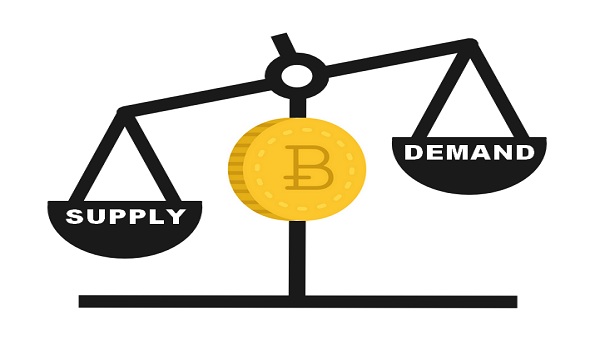Cryptocurrencies are the most volatile financial assets in the world, and millions of people wonder what drives crypto prices. To many crypto newcomers, it might seem that there aren't any rules in crypto and that the market doesn't follow any patterns. However, various factors drive crypto prices and contribute to the value of a specific digital currency. Unlike company stocks or commodities, the cost of cryptocurrencies depends on a mixture of factors contributing to a coin's value. You can't just point the finger at one key element and say that's what drives crypto prices. The crypto market is incredibly complex and has more than 20,000 active cryptocurrencies. Each project has its characteristics, communities, unique traits, and roadmaps. Many cryptocurrencies are so different from one another that different rules apply. Some projects are made as digital cash, while others solve specific technological issues.
All cryptocurrencies have in common that it's hard to pinpoint a specific, decisive factor and say that's what drives crypto prices. This article will explore the top factors that form the price of cryptocurrencies. We'll look at each element contributing to a digital currency's market price. Stay with us at Moralis Academy to learn more about what drives crypto prices and how you can use this knowledge to your advantage.

Moralis Academy's Bitcoin and Blockchain 101 course will introduce you to all of the essential aspects of blockchain technology and how it works. You'll also learn everything you need about Bitcoin, the leading digital currency.
The Volatility and Unpredictability of Cryptocurrencies
Before analyzing what drives crypto prices, we must look at digital currencies' volatility and unpredictability. Company stocks and commodities such as gold and oil have a vast global market. For example, the New York Stock Exchange, the world's largest stock market, has a valuation of over 24 trillion US dollars. In comparison, the crypto market's value is around 1 trillion USD. The stock market reached full global adoption decades ago, while the crypto market is barely ten years old.
Digital currencies are a whole new asset class yet to reach global mass adoption. Crypto is considered a volatile asset class since investors don't know what to expect from it in the future. Crypto enthusiasts claim that crypto will surely reach mass global adoption. On the other hand, skeptics and many TradFi investors claim that the crypto market will crash and never recover. With the stock market, there isn't any doubt that it's here to stay, and that's why stocks have a relatively low volatility level. Most company stocks barely change a few percent in value annually. For cryptocurrencies, it's normal to have several percent or even higher price swings within just a few hours.
Crypto is highly volatile, and because of this, it's considered a high-risk investment. Many investors need to figure out what drives crypto prices. One of the essential prerequisites for crypto to reach mass adoption is that users need to understand the driving forces behind the value of crypto.

What drives crypto prices?
With company stocks, it's pretty straightforward what drives their prices. When a company has a thriving business period, brokers new partnerships, and increases revenue, its stocks will increase in value. Likewise, if the business is going bad, the value of the company's stocks will drop.
With digital currencies, it's a different story. A project can have significant business partnerships, innovative tech solutions, and a fruitful business period but still drop in coin value. Numerous factors contribute to crypto prices. Business results are significant, but there are also additional factors you need to pay attention to. We've compiled a list of factors to help you understand what drives crypto prices. When you consider these factors, it will be much easier to know whether a specific project's price is more likely to increase or decrease.
Utility
The utility is a key factor contributing to a project's price. It's not enough anymore to provide users with digital cash services. Such features were innovative when Bitcoin (BTC) appeared in 2009. However, digital currencies nowadays need unique use cases to attract investors. Cryptocurrencies which solve specific problems are more likely to attract users and thus increase their market cap and coin price. It might attract investors when a crypto project provides users with authentic value, such as DeFi features, data storage, or NFT functionalities. For example, some of the top crypto projects on the market provide developers with the framework for launching decentralized apps (dapps). The most thriving coins on the market all have use cases. Bitcoin is the first digital cash crypto. Ethereum (ETH) is the leading ecosystem for launching dapps. Tether (USDT) is the largest stablecoin and a hedge against volatility.
If a cryptocurrency doesn't solve a specific problem or offer users some exact value, it doesn’t have utility. Coins without utility hardly have any perspective on the market except as speculative assets for traders to profit from their price swings.

Web3 decentralized applications are among the most popular use cases for digital currencies. Moralis has a quick guide on how to create a Web3 dapp in 3 steps. This guide will help you launch your Web3 dapp without unnecessary complications.
Development Roadmap
Every reputable crypto project has a doxxed team and a clear development roadmap. The roadmap is the plan for a cryptocurrency's future development. When a developer team launches a cryptocurrency, the project is in its initial stages of development. The team needs to have a clear vision of what it aims to accomplish and which features it wants to introduce. The roadmap needs to be realistic and showcase the direction in which the project is developing. If a development team creates a cryptocurrency and dumps it on the market without any detailed roadmap, it probably won't attract users.
Crypto enthusiasts need a solid reason to invest in a specific project. They need to see where the project is going, who is running it and is the team capable of delivering on its promises. If a developer team fails to fulfill a milestone from the roadmap, their project's price will probably take a beating in the form of a price drop. Investors bail out and exchange their coins for more reliable cryptocurrencies when projects go sideways. However, investors might flock to a project if the team is known to deliver features described in a project's roadmap successfully. This is especially true for projects that tackle important issues such as fast transactions, high scalability, and DeFi features.

If you're new to the crypto world and want to start from the basics, Moralis Academy has a Crypto for Beginners course. With the help of this course, you'll learn to understand the essentials of crypto and how digital currencies work.
The Crypto Community
In crypto, the community is vital for a project's success. The crypto community mainly focuses on Twitter and Discord as critical communication channels for crypto projects. Cryptocurrencies with large, hyped-up communities gain a lot of attention, contributing to their overall number of users and the market price. Every crypto needs a dedicated social media team to connect with the community and regularly publish project news. Crypto projects reach a vast portion of their users through social media. On social media, projects post everything about their development, partnerships, milestones, and business endeavors. Large and dedicated crypto communities tend to boost crypto projects' popularity and price.
However, the power of the crypto community can go both ways. If developers fail to deliver on roadmap promises and disappoint their communities, users can get angry and spread negative publicity about the project.
Such events can rapidly drop a project's user base, significantly impacting the coin's price.

Web3 is the newest internet iteration, and it uses blockchain technology. Web3 is transforming the way people use the internet and govern their assets. Check our Web3 ebooks to learn more about the innovations it's bringing. Moralis Academy also has a practical guide for Web3 developers on how to make a Web3 website.
Market Sentiment
Market sentiments heavily influence crypto prices. The Fear and Greed Index, which consists of six indicators, measures the crypto market sentiment. When fear is high, crypto prices tend to go downwards, while high greed levels tend to inflate crypto prices. When the whole market is dominated either by fear or greed, the price of most cryptocurrencies tends to have a downward or upward trend. The market goes through bearish and bullish cycles, influenced by factors such as general economic circumstances. Traders tend to be optimistic during the bull market and pump the price of digital currencies. On the other hand, many users have a conservative trading strategy during bear markets.
Market sentiments are beyond the control of specific cryptocurrencies and depend on macro factors beyond the crypto market. Market sentiment is a critical factor that drives the price of cryptocurrencies.

Currently, crypto market sentiments are in the fear zone, and investors are looking for less risky ways to engage in crypto trading. Moralis Academy has a practical guide on how to invest during a crypto bear market.
Media Coverage
During the last few years, the mainstream media began covering crypto topics, thanks to the exponential growth of the crypto market. The media coverage is great because it allows crypto to reach more users. However, the content of the media coverage is also essential. When large media outlets give favorable coverage to crypto projects and praise their features, these projects attract new investors. Media coverage can boost a project's market cap and trading volume.
On the other hand, negative coverage can cause considerable problems for cryptocurrencies because it might chase away some investors. Crypto projects can especially run into problems with the media in times of negative market sentiment. The media tends to publish pessimistic crypto media coverage when the market is down, which can lower prices further.
Crypto media outlets are also influential because they cover news about the development of specific projects. These outlets are the key media channel for attracting new users from the general crypto community.
Crypto Adoption
The adoption level of cryptocurrency in general and a specific project's adoption rate are essential factors that can form the price of crypto. As more retailers and institutions adopt crypto worldwide, the market grows and attracts more users. Every crypto project tends to secure as many business partnerships as possible. The main goal of these partnerships is to incorporate the project's features on new platforms and businesses. It all depends on what are the purposes of a crypto project.
For example, digital cash cryptocurrencies seek partnerships with retailers, payment services, and financial institutions. Dapp development ecosystems are looking for adoption among developers and software companies. The more businesses adopt a particular cryptocurrency, the more users it gains, which drives the project's value upwards. Projects with a stagnating adoption rate have a hard time when it comes to increasing in value.

You should check some of the Moralis Academy blockchain guides to understand blockchain technology. Our guides will help you reach a deeper understanding of various blockchain topics.
Supply and Demand
When an asset is scarce and has some characteristics that make it valuable, its price might rise over time thanks to high demand.
Similarly, if an asset's supply is highly-inflated and isn't in demand on the market, it probably won't rise in value. With cryptocurrencies, if a project has high utility, market demand, and is scarce, its value is likely to increase. For example, digital currencies that solve critical issues and have a limited amount of coins will likely cause high user demand. Most reputable crypto projects have a hard cap, the maximum amount of the coin's supply. The supply and demand for a cryptocurrency are essential for its market value. A currency with great utility but an extremely high supply probably will stay relatively low in price.

Crypto terms are pretty specific, and it can be challenging for crypto newcomers to understand them. Check the Moralis Academy crypto terminology guide to learn all the key terms.
Availability and Accessibility
A cryptocurrency must be widely available and easily accessible to reach a vast user base. If a crypto project has a high entry barrier that makes it difficult for users to get to it, it will be hard for the project to become famous.
Users need to be able to buy crypto on numerous exchange platforms and easily store it in their multi-currency crypto wallets. Because of this, developer teams try to secure as many crypto exchange listings for their projects as possible. If users can find a specific coin on many exchanges, buying it takes a few clicks. This makes the entry barrier very low because all users need is an exchange account and a crypto wallet.
Widely available projects attract more users, which can drive their prices higher.
Real-World Events
Apart from the various factors focused on the crypto market, real-world events also highly influence crypto prices. We can best see this during the current bear market cycle, which is affected by global political turmoil and the economic crisis happening in most parts of the world. When real-world events create a high-risk environment for investors, crypto prices will likely drop. During these periods, the whole market is going down. Investors tend to cash out crypto in such circumstances and invest in more stable assets such as stocks, commodities, and real estate.
However, when the global economic and political conditions take a turn for the better, this also impacts the crypto market and boosts the prices of digital currencies.
What Factors Drive Crypto Prices - Summary
Cryptocurrencies are far more volatile than stocks and commodities. However, if you understand what drives crypto prices, you can learn to analyze crypto projects and their price movements.
The factors described in this article all contribute to the prices crypto assets. Factors like utility, a project's roadmap, community, adoption rate, media coverage, supply, and demand are very useful when analyzing the price of specific cryptocurrencies. At the same time, real-world events and market sentiments are macro factors that influence the general crypto market and contribute to the overall rise or fall of crypto prices.

JavaScript is one of the leading Web2 programming languages. However, it's also the basis for many popular Web3 programming languages. Moralis Academy has a handy JavaScript Programming 101 course to help you start your Web3 developer journey.




